
The Kalamazoo bass guitar, or Kalamazoo KB (sometimes referred to as KB1), arrived in 1966, as a companion model to two Kalamazoo KG guitars that had been launched a year earlier. Like Gibson, and as the name suggests, they were produced in Kalamazoo, Michigan; however in a separate plant to the main 'Gibson' facility. You can read more about Gibson's relationship with Kalamazoo here.
The vintage Kalamazoo-brand bass guitars are perhaps not that well known outside the United States, due to their short production time (just a few years in the mid 1960s) and the lack of endorsement by well known musicians; however being made by Gibson, in the USA, out of genuine Gibson parts meant that they were better instruments than many in the same price range. Good condition examples can change hands for reasonable sums amongst vintage guitar enthusiasts, and players alike.
The original bass had the same styling as the guitars; that is, they were really a copy of the Fender Mustang. Though to be fair, they were fitted entirely with Gibson hardware. The audacity was compounded by offering the line in the same three bold finishes as the Mustang: red, white and blue. So Gibson hardware and $80 cheaper than a Fender...
As mentioned above, the first KB basses have a remarkable similarity to the Fender Mustang bass (see a 1966 KB bass). Fender's Mustang guitar launched in 1964, and the bass model only followed in mid 1966. Although the Kalamazoo bass is modelled on the guitars, it may have even preceded the Fender bass! At least they were both contemporaneous, both hitting stores in 1966.
For reasons unknown (although it would not be surprising if it was a threat from Fender), the KB bass and KG guitars were redesigned in 1966 with a new SG body style (have a closer look at a 1967 KB bass). There is no evidence (that we know of) of communication between Fender and Gibson on this matter, but if Fender objected to the Gibson Thunderbird as being too much like a Fender, they would certainly felt the same about the KB.
As the KG guitars were available a year before the basses, the Mustang-style instruments were made in far greater numbers than the SG style ones. For the basses, the reverse is true: the body style changed happened very quickly after the KB bass' launch, so Mustang-style examples are far less common than the SG style.
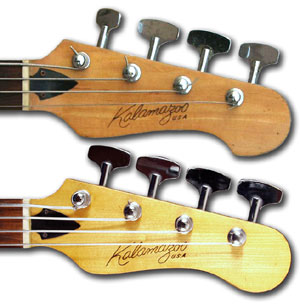 Two Kalamazoo bass headstocks: above, the more angular Thunderbird-style, below the smoother Fender-style
Two Kalamazoo bass headstocks: above, the more angular Thunderbird-style, below the smoother Fender-styleThe Kalamazoo series had a bolt-on maple neck; (something that Gibson, up until this point typically didn't do), a rosewood fingerboard, and were short scale. There were two subtly different headstock shapes, the first has a characteristic 'beak' shape, and is almost identical to that of the non-reverse Thunderbird (see images below). The second style, appearing on the SG-shaped bases is more like that of a Fender, though a little more rounded. The Kalamazoo logo is engraved on the headstock. The necks were actually pretty well made, and are highly playable.
This bass used some standard Gibson components; a typical EB series humbucker right up at the neck, as used in the EB0, EB2, EB3, Melody Maker bass and Epiphone Newport. This pickup in this position, has more affect on the sound than anything else. This bass does sound quite a lot like an EB0 (check out the Kalamazoo KB soundclips here). Tuning keys are the Japanese-made closed keys that were also used on the Melody Maker bass and a few EB basses. The bar bridge had been in use on all EB bass models, but around 1966/67 this was replaced by the two-point intonatable bridge. From this point, the KB bass was the only one using these bridges - likewise the only one using the old-style (and position) chrome handrest.
The scratchplate was almost identical (except some minor screw hole differences) to the Melody Maker bass, but the fingerrest was not rosewood as on all Gibsons, but actually plastic. The body material is not specified in Kalamazoo literature, but is supposedly a wood-laminate of one or more unspecified species, produced by a composite-wood manufacturer in Wisconsin. There were three colours: Flame Red, Glacier White, and Las Vegas Blue - the same three colours of the Fender Mustang of this period. These were not the expensive nitrocellulose finishes applied to Gibsons, but again catalogue descriptions are not specific, presumably polyurethane.
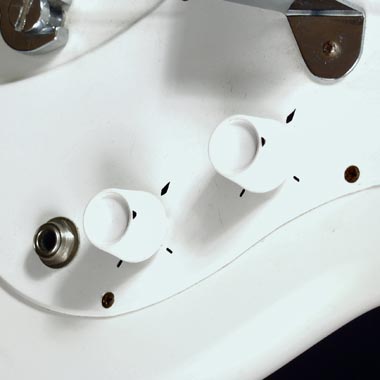
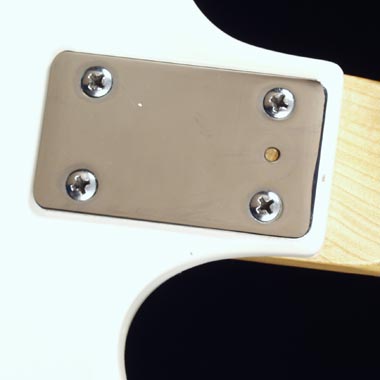
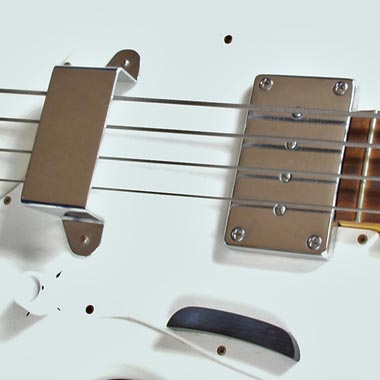
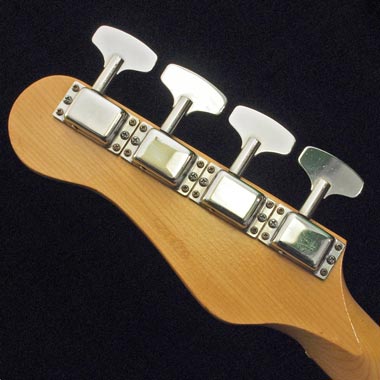
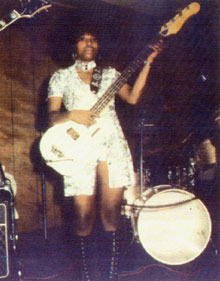 Dianne Bowens, of Tony Bowens and the Soul-Choppers with a Kalamazoo KB bass. Have a listen to Dianne getting down with her KB bass on the track Boilin' Water from the album The World's Rarest Funk 45s on Jazzman records. The deep mellow bass tone is perfect for this kind of early seventies funk - doesn't it sound great?
Dianne Bowens, of Tony Bowens and the Soul-Choppers with a Kalamazoo KB bass. Have a listen to Dianne getting down with her KB bass on the track Boilin' Water from the album The World's Rarest Funk 45s on Jazzman records. The deep mellow bass tone is perfect for this kind of early seventies funk - doesn't it sound great?Gibson had produced cheaper instruments with Kalamazoo brand on the headstock during the depression of the 1930s and post war 1940s, but it had not previously been used on a solid-body guitar. Sales were initially good, and during 1966-67 this was by far the best selling bass made in Kalamazoo. See the compiled Kalamazoo bass shipping figures here. Unlike the Epiphone instruments, the Kalamazoo basses were not produced side-by-side with Gibsons; they were produced at Gibsons second Kalamazoo factory (plant II, 416E Ransom street) which had been opened in 1962 to produce pickups and electronics.
The Kalamazoo brand was an attempt to emulate Fender's approach to guitar building: good quality components, assembled on a production line. It was a useful way to use up obsolete Gibson parts, and provide an affordable, American-made instrument, with many characteristic Gibson features. However, with the sale of Gibson from CMI to Norlin in late 1969 the business was once again restructured. The Kalamazoo brand was discontinued, and the new Japanese-made Epiphone range became Gibson's entry-level brand.
A common misconception about Epiphone is that its 1960s guitars and basses were cheaper versions of the Gibson lines. From the late 1950s until 1969 Gibson and Epiphone instruments were made side by side to Gibsons, using the same woods, techniques and (often) components. The purpose of the Epiphone range was to expand the Kalamazoo plants reach, specifically in terms of high-end instruments; those that had been Gibson's competition; but also to circumvent certain supply agreements (Gibsons protective territorial policy). There was a waiting list to become a Gibson dealer, but distributing Epiphone, Gibson was able to offer its (closely related) Epiphone models to a wide range of dealers without upsetting existing ones.
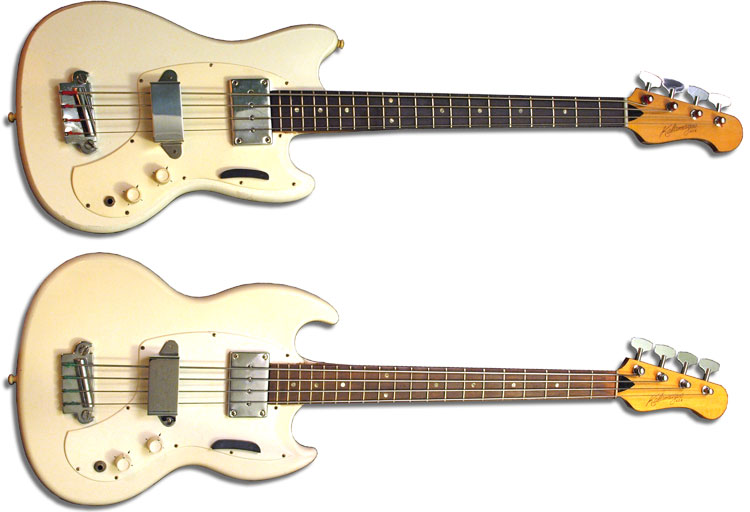
The two Kalamazoo bass body styles are shown here, with the Mustang shape top and the SG shape below.
As Gibson bass production figures go, the Kalamazoo KB bass sold well, but still only a quarter as many as the Kalamazoo KG guitars (see the KG guitar shipping totals). Unusually for the 1960s, the available shipping figures for the Kalamazoo bass are split by color. The shipping totals are also listed for 3 Gibson/Epiphone comparable models: EB0, Newport (EBS) and Melody Maker bass. As can be seen, the Kalamazoo bass greatly outsold the other models in 1966 and '67, though it slips behind in 1968, and production almost stops in '69 - the EB0s peak year. The Melody Maker bass is another cheaper model, rarer than the others, even though the shipping figures for this bass are most likely incomplete.
| 1966 | 1967 | 1968 | 1969 | Total | |
|---|---|---|---|---|---|
| Flame Red | 739 | 1312 | 523 | 193 | 2767 |
| Glacier White | 1347 | 501 | 290 | 2138 | |
| Las Vegas Blue | 897 | 342 | 143 | 1382 | |
| Total Kalamazoo KB bass | 2983 | 2155 | 956 | 193 | 6287 |
| Gibson EB0 | 1660 | 1676 | 1350 | 3018 | 7704 |
| Gibson Melody Maker bass | 27 | 27 | |||
| Epiphone Newport | 664 | 136 | 65 | 72 | 937 |
The Kalamazoo bass was cheap; approximately half the price of the EB0 and still a good deal cheaper than Gibson's cheapest bass, the Melody Maker, whilst having the same pickup (and therefore a good deal of the sound) of both models. And beyond that it was still $80 cheaper than the Fender Mustang bass. No wonder it sold well initially.
| 1966 | 1967 | 1968 | 1969 | |
|---|---|---|---|---|
| Kalamazoo KB bass | $119.50 | $119.50 | $119.50 | |
| Fender Mustang bass | $189.50 | $189.50 | $199.50 | $229.50 |
| Gibson EB0 | $240 | $240 | $259.50 | $275 |
| Gibson Melody Maker bass | $209.50 | $227.50 | $240 | |
| Epiphone Newport | $240 | $250 | $270 |
$750
$737
$999
$695
$449
£1500